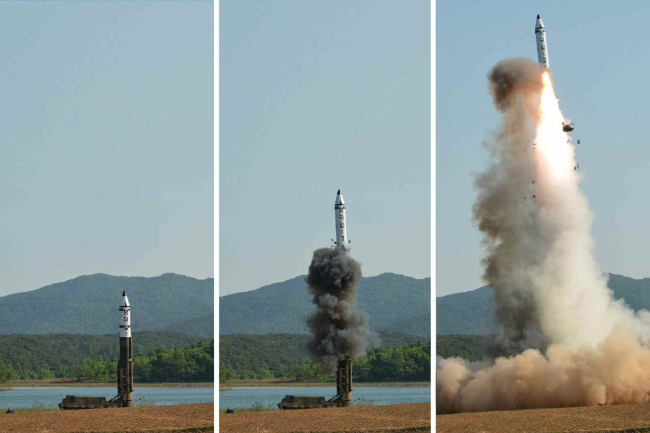Since the beginning of this year, North Korea has launched a total of eight ballistic missiles, two of them after President Moon Jae-in was sworn in as South Korea’s commander in chief on May 10.
Through the tests, Pyongyang has demonstrated capability using solid fuel to avoid detection and surgical strikes, and inched closer to acquiring re-entry technology for liquid-fueled intercontinental ballistic missiles.
 |
A new intermediate-range ballistic missile, called the Pukguksong-2, is launched from the vicinity of Pukchang in the country's western province on May 21, 2017, in this combined photo released by the Rodong Sinmun, the North's ruling party organ, on May 22. (For Use Only in the Republic of Korea. No Redistribution) (Yonhap) |
The latest sets of missiles -- the medium-range, solid-fueled Pukguksong-2 fired Sunday and the intermediate-range, liquid-fueled Hwasong-12 fired exactly a week earlier -- are the latest examples of such capability and are likely to pose a challenge to South Korea’s missile defense systems, analysts said.
“I think there might have been rivalry between the scientists developing solid fuel and liquid fuel. Such rivalry could have fueled the incredible speed of North Korea’s technology advancement,” said Kim Dong-yub, a professor at the Institute for Far Eastern Studies at Kyungnam University.
Unlike the liquid-fueled missiles which must be fueled after they are in place at the launch site, solid-fueled ones have the advantage of fuel preloading, which allows them to be fired quickly after being moved to a launch site.
John Schilling, an aerospace engineer and rocket specialist, estimated that the Pukguksong-2 could be launched on five minutes’ notice, compared with 30 to 60 minutes for older missile types, according to The Washington Post.
Alongside the efforts to replace liquid-fueled missiles with solid-fueled ones, North Korea has also sought to transform the existing liquid-fueled missiles into ICBM-level missiles equipped with two-stage rocket engines, the analysts added.

Lee Chun-geun, a researcher at the Science and Technology Policy Institute, said North Korea would develop a new version of the two-stage liquid-fueled Hwasong 12 missile, which currently uses a single-stage missile engine.
The key to securing ICBM capability is to achieve re-entry technology, the largest hurdle for North Korea to miniaturize a nuclear warhead and enable it to be mounted on a missile. The communist regime had been considered to be years away from mastering the technology.
After North Korea test-fired the Hwasong 12, Pyongyang’s state-run Korean Central News Agency claimed that the missile was capable of carrying a “large-size, heavy nuclear warhead” to a target on the US and had come through “the worst re-entry situation” and struck its intended target.
Although South Korea’s Joint Chiefs of Staff said further analysis is needed to verify North Korea’s claims, some US and South Korean defense officials suggested that the North might have perfected re-entry technology.
Citing two unidentified US defense officials, NBC reported Friday that Hwasong-12’s re-entry vehicle successfully re-entered the atmosphere, adding that the process was controlled and the vehicle did not burn up before landing in the sea near Russia.
According to a report from JoongAng Ilbo on Thursday, an intelligence official said the missile succeeded in re-entering the atmosphere, claiming that the vehicle had successfully communicated with a data center on the ground after surviving 5,000 degrees Celsius and extreme vibration.
By Yeo Jun-suk (
jasonyeo@heraldcorp.com)









![[Weekender] Korea's traditional sauce culture gains global recognition](http://res.heraldm.com/phpwas/restmb_idxmake.php?idx=644&simg=/content/image/2024/11/21/20241121050153_0.jpg)